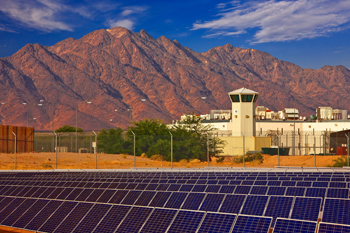California Prisons Go Solar as Part of Green Initiative
 DELANO, Calif. — The California Department of Corrections and Rehabilitation (CDCR) recently announced that solar energy installations at four of its prisons are now operating at full capacity. The department began installing large solar arrays at its facilities in 2006, working with international utility company Sun Edison, based in Belmont, Calif.
DELANO, Calif. — The California Department of Corrections and Rehabilitation (CDCR) recently announced that solar energy installations at four of its prisons are now operating at full capacity. The department began installing large solar arrays at its facilities in 2006, working with international utility company Sun Edison, based in Belmont, Calif.
A dedication ceremony was held at the North Kern State Prison in Delano, Calif. in late October, when that installation went fully online, making it the fourth facility to complete solar projects since the program began.
Solar fields were completed at Chuckawalla Valley State Prison in Blyth, Calif. in 2006, while an installation at nearby Ironwood State Prison went online in 2008. California Correctional Institution in Tehachapi got its installation in early 2012. Additional arrays were constructed near the existing Chuckawalla and Ironwood installations at the same time.
“These solar fields benefit the environment and show a responsible stewardship of taxpayer dollars,” said CDCR secretary Matthew Cate. “These solar fields will prevent a billion pounds of greenhouse gases from being emitted to the air and make the prisons less reliant on power generated by natural gas and nuclear sources.”
The projects have all been completed by Sun Edison with no cost to taxpayers as part of an agreement for the CDCR to receive its energy from the utility company over the long- term.
"With our agreement, we are able to lock in a low electricity rate for the next 20 years and avoid paying utility demand charges during peak demand hours in the summer," said Chris Meyer, director of CDCR’s facility planning, construction and management division. "These projects not only help the state save money during these lean economic times but will help stimulate the economy with new construction."
A new project is currently underway at Los Angeles State Prison in Lancaster, scheduled for completion in 2013. An expansion of the Tehachapi field is also expected to be completed around the same time.
All told, the projects have added 83,000 solar panels, generating 25 megawatts of power per year and saving taxpayers $57 million in energy costs over the next 20 years. The combined power output is enough to provide electricity to over 89,00 standard homes and the projects will negate the equivalent of more than 90,000 cars worth of greenhouse gas emissions.
The state has already awarded contracts for the utility to install an additional 20 megawatts of solar capacity at other prisons, mostly in northern California. The sites are still being evaluated so specific plans and locations haven’t been made public yet. The CDCR anticipates these projects will save an additional $45 million over 20 years.
“Helping the CDCR cut electricity bills and reduce its carbon footprint is very rewarding,” said Attila Toth, general manager of distributed generation solar for Sun Edison. “By working with our finance partners we’ve been able to complete these projects without using California taxpayer general funds and generate significant savings for the state. Our management and operations capabilities are designed to ensure high performance for the CDCR over the next 20 years.”
The installation of solar fields is part of CDCR’s Going Green Initiative, which also involves recycling and water conservation efforts. Projects resulting from the initiative are all paid for without using any state general funds and are financed with low interest loans from programs like the Federal American Recovery and Reinvestment Act
